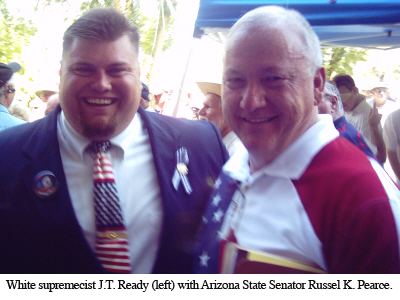HUFFINGTON POST
John Carlos Frey
3/18/10
On March 21, 2010 immigrant rights advocates by the tens of thousands will be in Washington, DC to make their case known to the nation. For me, the need for comprehensive immigration reform is obvious. I was born in Mexico of U.S. citizen parents. My parent's citizenship automatically made me a U.S. citizen even though I was born in a foreign country. By birth, I have been afforded the privileges of U.S. society, for which I am grateful. Through my work as a filmmaker, I have come to personally know those that seek refuge and opportunity in the United States and are not as fortunate as I. I have met people that live in constant fear of deportation, of being ripped from stable jobs, family and loved ones. I have seen and documented the migrant corpses that litter the southwestern deserts of the United States -- people who are so poor and desperate they will risk their lives for a job. I was born to the "right" parents so I can live better and freer than 99% of the entire world's population. My U.S. citizenship was a gift. There are millions living and working in this country that were not so fortunate and millions more coming that will be forced to live underground, afraid, taken advantage of and without a voice. That is the system we have today and it is at best, reprehensible.
Several weeks ago I met a man named Fernando who had been deported after being pulled over for a burned out tail light on his truck. Fernando spoke English, but not perfectly. He did not have a driver's license and of course, he was Latino. In addition to dealing with Fernando's infraction, the police officer that pulled him over also asked Fernando for proof of legal residency. Fernando truthfully admitted to the officer he did not have any legal papers. He was detained and deported to Mexico several days later. What the officer did not ask was how long Fernando had been in the United States. If so, he would have answered, 25 years. Fernando was not asked if he had U.S. citizen children -- he has three -- ages 8 to 16. His wife is a legal U.S. resident. His parents are U.S. citizens. Fernando was deported in spite of all this information because it is irrelevant given our current immigration system. If that is not enough insult, Fernando will have to stay in Mexico for approximately 10 years while his application to legally reenter the U.S. is under consideration. The fact that he has worked on a U.S. farm providing manual labor for 25 years means nothing to immigration courts. The fact that he has no criminal record, never been late on his rent or utility bills, goes to church and coaches his son's soccer team is meaningless.
Some may say that Fernando should never have crossed the U.S. Mexico border without documents. Fernando was covertly invited to the U.S. to work amongst the millions of undocumented laborers in our agricultural industry. Each year we (businesses) import unauthorized labor to the United States by the hundreds of thousands. Yes, I say we, they are here, they are working and we are benefiting. We are a magnet for undocumented labor and we look the other way.
People say, "He should get in line." "My Grandparents got in line." Our current immigration system provides no line for Fernando. If our ancestral immigrants were subject to today's immigration laws they would have never gained legal access. There is no fine Fernando can pay to make restitution, there is no judge he can plea his case before, the cries of his family carry no legal weight and there is nothing he can do but apply for legal reentry and wait ten years to be with his family, maybe longer.
Fernando found himself in a shelter of deportees in Tijuana, MX. He was desperate. He had a wild, distant stare in his eyes. He appeared catatonic. The only thing he talked about was seeing his wife and children. He was thinking about crossing the border through the desert. He won't wait ten years for his immigration application to be considered. I told him the desert is dangerous, I even told him I made a film about migrants dying in the desert. I offered to show it to him in the hope he would not make that journey. He left yesterday, and crossed the border into the Arizona desert. I have no way to contact him. I have no way to know if he will ever find his way to his family. I have no way to know if he is still alive.
Inhumanity is the cornerstone of our current immigration system. The work is here and the poor are there. Desperate people will find a way to reach opportunity and reach the people they love. If I were in the same situation, I would do the same thing. The need for comprehensive immigration reform is urgent. People are dying, workers are being abused and Fernando should be with his wife and children.
On the eve of what may be the beginning of the immigration reform debate, are we a big enough country to consider the poor and desperate amongst us? Can compassion and forgiveness guide our judgment or will we hate, fear monger and slog it out healthcare style? I wonder how many of us are U.S. citizens by sheer luck and if so, can we extend the bounty that was freely given to us?


